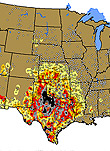U.S. scientists say the summer of 2011 was the nation’s second-warmest on record, with an average temperature of 74.5 degrees F from June through August — about 2.4 degrees higher than long-term averages — and with four states setting new summer records. Heat conditions were particularly blistering during August, with an average temperature of 75.7 degrees F, about 3 degrees warmer than the average between 1901 and 2000, according to the National Oceanic and Atmospheric Administration (NOAA). Across the southern U.S., record temperatures and below-average precipitation combined to create destructive drought conditions, with some areas experiencing a drought of greater intensity — though not yet duration — than during the 1930s and 1950s, according to the Palmer Hydrologic Drought Index. Meanwhile, states across the northeastern U.S. experienced wetter-than-normal conditions in August, with Hurricane Irene contributing to the wettest recorded Augusts for four states — New Jersey, New York, Vermont, and New Hampshire.
Second-Warmest U.S. Summer Recorded in 2011, Federal Agency Says
More From E360
-
SPACE
Scientists Warn of Emissions Risks from the Surge in Satellites
-
WILDLIFE
A Troubling Rise in the Grisly Trade of a Spectacular African Bird
-
MINING
In Myanmar, Illicit Rare Earth Mining Is Taking a Heavy Toll
-
INTERVIEW
How Batteries, Not Natural Gas, Can Power the Data Center Boom
-
ANALYSIS
As U.S. and E.U. Retreat on Climate, China Takes the Leadership Role
-
Solutions
From Ruins to Reuse: How Ukrainians Are Repurposing War Waste
-
ANALYSIS
Carbon Offsets Are Failing. Can a New Plan Save the Rainforests?
-
Energy
Facing a Hostile Administration, U.S. Offshore Wind Is in Retreat
-
Biodiversity
As Jaguars Recover, Will the Border Wall Block Their U.S. Return?
-
WATER
An E.U. Plan to Slash Micropollutants in Wastewater Is Under Attack
-
INTERVIEW
This Data Scientist Sees Progress in the Climate Change Fight
-
Climate
As Floods Worsen, Pakistan Is the Epicenter of Climate Change
